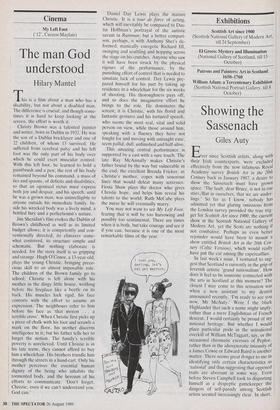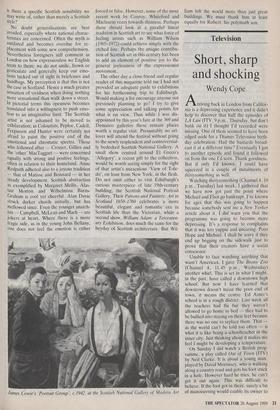Exhibitions
Scottish Art since 1900 (Scottish National Gallery of Modern Art, till 24 September) El Greco: Mystery and Illumination (National Gallery of Scotland, till 15 October) Patrons and Painters: Art in Scotland 1650-1760 William Adam: a Tercentenary Exhibition (Scottish National Portrait Gallery, till 8 October)
Showing the Sassenach
Giles Auty
Ever since Scottish artists, along with their Irish counterparts, were excluded effectively from the now infamous Royal Academy survey British Art in the 20th Century back in January 1987, a desire to show the Sassenach must have grown apace. 'The fault, dear Bruce, is not in our stars,/But in ourselves, that we are under- lings.' So far as I know, nobody has admitted yet that glaring omissions from the London survey provided the true trig- ger for Scottish Art since 1900, the current show at the Scottish National Gallery of Modern Art, yet the Scots are nothing if not combative. Perhaps an even better rejoinder would have been to mount a show entitled British Art in the 20th Cen- tury (Celtic Version), which would really have put the cat among the capercaillies.
In last week's issue, I ventured to sug- gest that Scotland is currently in the grip of feverish artistic 'grand nationalism'. How does it feel to be someone connected with the arts in Scotland at this moment? The closest I may come to this sensation was when a new assistant to my dentist announced recently, 'I'm ready to see you now, Mr McAuty.' Were I the black Highlander that such a name might imply, rather than a mere Englishman of French descent, I would certainly be proud of my national heritage. But whether I would place particular pride in the sensational overkill of William McTaggart, say, or the occasional chromatic excesses of Peploe, rather than in the idiosyncratic intensity of a James Cowie or Edward Baird is another matter. There seems great danger to me in identifying only certain characteristics as 'national' and thus suggesting that opposed traits are aberrant in some way. Even before Steven Campbell took to disporting himself as a dyspeptic gamekeeper the dangers of self-parody among Scottish artists seemed increasingly clear. In short, is there a specific Scottish sensibility we may write of, rather than merely a Scottish Style?
No doubt generalisations are best avoided, especially where national charac- teristics are concerned. Often the myth is outdated and becomes overdue for re- placement with some new comprehension. Nevertheless foreigners still comment in London on how expressionless we English seem to them: we do not smile, frown or gesticulate and generally keep our emo- tions tucked out of sight in briefcases and handbags. My perception is that this is not the case in Scotland. Hence a much greater sensation of vividness when doing nothing more sensational than walk down a street. In pictorial terms this openness becomes translated into a willingness to push emo- tion to an imaginative limit. The Scottish artist is not ashamed to be moved to exhilaration; as Colourists, Peploe, Cade11, Fergusson and Hunter were certainly not afraid to paint the positive end of the emotional and chromatic spectra. Those Who followed after — Crozier, Gillies and the 'other' MacTaggart — were concerned equally with strong and positive feelings, often in relation to their homeland. Anne Redpath adhered also to a joyous tradition — that of Matisse and Bonnard — in her steady development. Scottish abstraction as exemplified by Margaret Mellis, Alas- tair Morton and Wi lhelmi na Barns- Graham is cool yet cheerful. Alan Davie struck darker chords initially, but has mellowed since. Even the younger anarch- ists Campbell, McLean and Mach are jokers at heart. Where there is a more tragic side, as in the young John Bellany, one does not feel the emotion is either forced or false. However, some of the most recent work by Conroy, Whiteford and Maclaurin veers towards thinness. Perhaps these should look at a parallel linear tradition in Scottish art to see what force of feeling artists such as William Wilson (1905-1972) could achieve simply with the etched line. Perhaps the unique contribu- tion of Scottish art in this century has been to add an element of positive joy to the general joylessness of the expressionist movement.
The other day a close friend and regular reader of this magazine told me I had not provided an adequate guide to exhibitions for his forthcoming trip to Edinburgh. Would making a list encourage anyone not previously planning to go? I try to give some appreciation and talking points for what is on view. Thus while I was dis- appointed by this year's fare at the 369 and Demarco galleries these remain places worth a regular visit. Presumably no art- lover will attend the festival without going to the newly resplendent and controversial- ly bedecked Scottish National Gallery. A small show centred around El Greco's 'Allegory', a recent gift to the collection, would be worth seeing simply for the sight of that artist's miraculous 'View of Tole- do', on loan from New York, in the flesh. Do not omit either to visit Edinburgh's curious masterpiece of late 19th-century building, the Scottish National Portrait Gallery. Their Patrons and Painters: Art in Scotland 1650-1760 celebrates a more beautiful, elegant and romantic era in Scottish life than the Victorian, while a second show, William Adam: a Tercenten- ary Exhibition, does much the same for the heyday of Scottish architecture. But Wil-
James Cowie 's 'Portrait Group', c.1942, at the Scottish National Gallery of Modern Art ham left the world more than just great buildings. We must thank him at least equally for Robert, his polymath son.











































 Previous page
Previous page